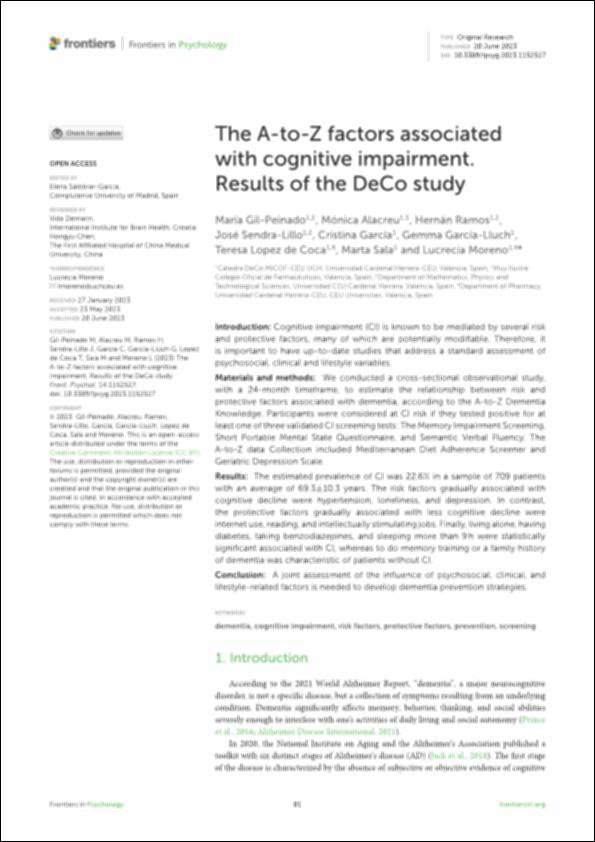Please use this identifier to cite or link to this item:
http://hdl.handle.net/10637/14483The A-to-Z factors associated with cognitive impairment results of the DeCo study
| Title: | The A-to-Z factors associated with cognitive impairment results of the DeCo study |
| Authors : | Gil Peinado, María Alacreu García, Mónica Ramos García, Hernán Sendra Lillo, José García García, Cristina García Lluch, Gemma López de Coca Pérez, Teresa Sala Climent, Marta Moreno Royo, Lucrecia |
| Keywords: | Demencia - Prevención.; Dementia - Risk factors.; Dementia - Prevention.; Demencia - Factores de riesgo.; Cognition - Damage.; Procesos cognitivos - Deterioro. |
| Publisher: | Frontiers Media |
| Citation: | Gil-Peinado, M., Alacreu, M., Ramos, H., Sendra-Lillo, J., García, C., García-Lluch, G., Lopez de Coca, T., Sala, M. & Moreno, L. (2023). The A-to-Z factors associated with cognitive impairment : results of the DeCo study. Frontiers in Psychology, vol. 14, art. 1152527 (20 jun.). DOI: https://doi.org/10.3389/fpsyg.2023.1152527 |
| Abstract: | Introduction: Cognitive impairment (CI) is known to be mediated by several risk and protective factors, many of which are potentially modifiable. Therefore, it is important to have up-to-date studies that address a standard assessment of psychosocial, clinical and lifestyle variables. Materials and methods: We conducted a cross-sectional observational study, with a 24-month timeframe, to estimate the relationship between risk and protective factors associated with dementia, according to the A-to-Z Dementia Knowledge. Participants were considered at CI risk if they tested positive for at least one of three validated CI screening tests: TheMemory Impairment Screening, Short Portable Mental State Questionnaire, and Semantic Verbal Fluency. The A-to-Z data Collection included Mediterranean Diet Adherence Screener and Geriatric Depression Scale. Results: The estimated prevalence of CI was 22.6% in a sample of 709 patients with an average of 69.3±10.3 years. The risk factors gradually associated with cognitive decline were hypertension, loneliness, and depression. In contrast, the protective factors gradually associated with less cognitive decline were internet use, reading, and intellectually stimulating jobs. Finally, living alone, having diabetes, taking benzodiazepines, and sleeping more than 9 h were statistically significant associated with CI, whereas to do memory training or a family history of dementia was characteristic of patients without CI. Conclusion: A joint assessment of the influence of psychosocial, clinical, and lifestyle-related factors is needed to develop dementia prevention strategies. |
| Description: | Este artículo se encuentra disponible en la siguiente URL: https://www.frontiersin.org/articles/10.3389/fpsyg.2023.1152527/full Este artículo de investigación pertenece a la sección "Psychology of Aging". |
| URI: | http://hdl.handle.net/10637/14483 |
| Rights : | http://creativecommons.org/licenses/by/4.0/deed.es |
| ISSN: | 1664-1078 (Electrónico) |
| Language: | es |
| Issue Date: | 20-Jun-2023 |
| Center : | Universidad Cardenal Herrera-CEU |
| Appears in Collections: | Dpto. Farmacia |
Items in DSpace are protected by copyright, with all rights reserved, unless otherwise indicated.


